![]()
![]()
![]()
Use LEFT and RIGHT arrow keys to navigate between flashcards;
Use UP and DOWN arrow keys to flip the card;
H to show hint;
A reads text to speech;
106 Cards in this Set
- Front
- Back
|
Neisseria sp description |
Gran neg diplococci (kidney bean) Oxidase pos Catalase pos |
|
|
Neisseria normal flora |
May be normal flora in respiratory tract and genital tracts |
|
|
Neisseria gonorrhea |
Always a pathogen! Primary site in Male- urethra Primary site in female- endocervix Also rectum, pharynx, joints |
|
|
Male infection of neisseria gonorrhea |
Diagnose by gram stain Intracellular gram neg diplococci |
|
|
Female infection of neisseria gonorrhea |
Diagnosis is by culture Gram stain cannot diagnose bc large amounts of normal flora |
|
|
Culture requirement for neisseria gonorrhea |
Requires enriched media Chocolate agar for sterile sites MTM for non sterile sites Small gray translucent |
|
|
Thayer Martin agar |
Selective media for gonorrhea Chocolate agar that includes Vanco, colistin, nystatin- inhibitors |
|
|
Carbohydrate utilization test Traditional method |
Used to differentiate neisseria spp Breakdown of sugars decrease ph Red to yellow is positive |
|
|
Carbohydrate utilization test Rapid method |
Preformed enzymes breakdown sugars and forms acids Non growth dependent (dead) 2 hrs |
|
|
Chart of carbohydrate utilization |

|
|
|
NET test |
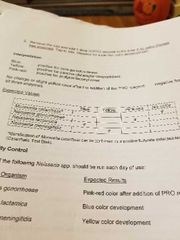
Used to differentiate neisseria spp |
|
|
NAAT |
Nucleic acid amplification test Detect RNA or DNA from cervical, urethral, or urine specimen |
|
|
Treatment of neisseria gonorrhea |
Use beta lactamase to determine if resistant to penicillin by that method Ceftriaxone |
|
|
Gardnerella vaginalis |
Gram variable coccobacilli Doesn't know what it wants to be Clue cells |
|
|
N. meningitidis description |
Can exist as normal flora or be path 3-30% of pop are carriers Peak incidence of infection 6m-2y |
|
|
Acute purulent meningitis |
Fever, stiff neck, confusion,headache Large pmns in spinal fluid Transmission oral secretions |
|
|
Meningococcemia |
N meningitidis enters blood stream 25% mortality rate Purpura, DIC, shock |
|
|
Diagnosis of neisseria meningitidis |
Gram stain of CSF- kidney bean gram neg diplococci and many PMNs Blood culture for sepsis Serotyping, carb utilize, NET |
|
|
Treatment of neisseria meningitidis |
Penicillin |
|
|
Prevention of neisseria meningitidis |
Vaccine Doesn't protect against type B |
|
|
Moraxella catarrhalis description |
Normal flora of upper respiratory (in small numbers) Infection in eye, ear, sinus, bronchitis, pneumonia |
|
|
Colony morphology moraxella catarrhalis |
Grows well on BAP and chocolate Waxy |
|
|
Moraxella catarrhalis test |
Oxidase pos Catalase pos Positive butyrate esterase tes Use carb test or net to differentiate from neisseria Dnase pos |
|
|
Positive butyrate esterase test |
Blue green Done like PYR |
|
|
Haemophilus description |
Gram neg coccobacilli Require complex enriched media |
|
|
Haemophilus normal flora |
Normal flora of upper respiratory tract May cause conjunctivitis, otitis media, sinusitis, pneumonia |
|
|
H influnzae |
Type b causes most signf. disease Peak incidence is 2m to 6y HIB vaccine |
|
|
H influenzae virulence factors |
Capsule-antiphago & anti complemt IgA protease Pili |
|
|
IgA protease |
Cleaves secretory IgA in mucous membranes |
|
|
Diseases caused by H influenzae |
Meningitis Acute epiglottitis Cellulitis Arthritis- children under 2 |
|
|
Diagnosis of acute epiglottitis caused by H influenzae |
Blood culture Not a throat swab May cause collapse |
|
|
Hemin |
Factor X Provided by unlysed rbcs |
|
|
NAD |
Factor V From chocolatizing the blood |
|
|
H influenzae growth |
Medium sized, mouse nest smell Growth on chocolate agar Satelite colonies around S aureus on BAP Needs factor X and V |
|
|
H aegyptius |
Usual cause of pink eye Koch weeks bacillus Can't distinguish from h influenzae |
|
|
Haemophilus factor requirements |
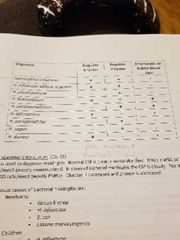
|
|
|
Usual causes of meningitis in newborn |
Group B strep H influenzae E coli Listeria |
|
|
Usual causes of meningitis in children |
H influenzae N meningitidis S pneumoniae |
|
|
Usual causes of meningitis in young adults |
N meningitidis |
|
|
Usual causes of meningitis in adults |
S pneumoniae S aureus E coli N meningitidis Listeria |
|
|
H ducreyi |
Strict human pathogen Causes tropical STD chancroid Buboes- swollen lymph nodes Enhances transmission of HIV Gram stain shows school of fish |
|
|
HACEK group |
Slow growing, fastidious, gram neg bacilli requiring CO2 Causative agents of endocarditis |
|
|
H in HACEK |
Haemophilus spp |
|
|
A in HACEK |
Aggregatibacter actinomycetecomitans |
|
|
C in HACEK |
Cardiobecterium hominis |
|
|
E in HACEK |
Eikenella corrodons Human bite wounds or fist |
|
|
K in HACEK |
Kingella Pediatric bone and joint infections |
|
|
Pasturella multocida |
Gram neg coccobacilli faint staining No growth on MAC, grow on BAP,CH Cat bites Treat with penicillin |
|
|
Brucellosis |
Umdulant fever Mediterranean fever Contacted from animals Bact is carried by PMNs intracellular |
|
|
B abortus |
Cattle |
|
|
B melitensis |
Sheep goats |
|
|
Sequelae of brucellosis |
Systemic deep seated disease resulting in various long term sequelae |
|
|
3 clinical stages of brucellosis |
Acute Sub chronic or undulant form Chronic form |
|
|
Acute brucellosis |
Non specific symptoms Fever, malaise, headache |
|
|
Sub chronic brucellosis |
Occurs within a year Drenching sweats in afternoon Fever spikes and continue for 2 yrs |
|
|
Chronic brucellosis |
Depression, arthritis, chronic fatigue syndrome |
|
|
Diagnosis of brucellosis |
Blood culture, bone marrow Lysis centrifugation Grows slow 2-4 weeks Serological test for AB |
|
|
ID of brucella |
Rapidly hydrolyze urea Less than 30 min or 30 to 120 min Grows in aniline dyes AB test more common Rule out and refer is susp of brucella |
|
|
Prevention of brucellosis |
Pastuerizing of dairy products |
|
|
Francisella tularensis |
Causes tularemia From fleas on rabbits Causes ulceroglandular sign Can be spread person to person |
|
|
Francisella tularensis morphology |
Tiny gram neg coccobacilli can hardly see Grows on BAP Choc not on MAC EMB Oxidase neg Catalase weak pos Urease neg Beta lactamase pos (part of id) |
|
|
Francisella tularensis ID |
Use rule out refer Serodiagnosis best Hazardous to culture |
|
|
Legionella |
Contains 50 spp and 70 serotypes Ubiquitous Inhalation acquired Asymptomatic to life threatening |
|
|
Legionella pneumophila gram stain |
Gram neg rods pleomorphic Motile Stain poorly with gram stain use 10 min safranin |
|
|
Legionella pneumophila culture |
Acid treatment may have better recovery Needs L-cysteine for growth Buffered charcoal yeast extract agar Gray white or blue green glistening Ground glass with special scope |
|
|
BCYE agar |
Buffered charcoal yeast extract agar Can be non selective or semi selective With L-cysteine grows legionella |
|
|
Non culture diagnosis of legionella |
Direct fluorescent AB Urine antigen test |
|
|
Presentation of legionella pneumophilia |
Legionnaires disease Pontiac fever Asymptomatic |
|
|
Legionnaires disease |
Severe pneumonia Community acquired pneumonia |
|
|
Pontiac fever |
Non pneumonic form Mild self limiting Last 2-5 days |
|
|
Epidemiology of legionella |
Man made water systems Organism can tolerate chlorine Not person to person transmission |
|
|
Bordetella pertussis |
Gram neg coccobacillis aerobic Fastidious, survives short while outside human respiratory tract Strict human pathogen |
|
|
Bordetella pertussis media |
Regan Lowe- drops of mercury q Bordet Gengou- culture media |
|
|
ID of bordetella pertussis |
PCR is most reliable and accurate Need nasopharyngeal swab |
|
|
B bronchiseptica |
Kennel cough |
|
|
3 stages of pertussis |
Catarrhal stage Paroxysmal coughing stage Convalescent stage |
|
|
Catarrhal stage |
Non specific cold like symptoms Highly contagious |
|
|
Paroxysmal stage (2nd) |
Sudden onset severe rapid cough Vomiting from cough Characteristic whoop inhalation |
|
|
3rd stage convalescent |
4 weeks after symptoms Frequency and severity of cough diminishes May take weeks to months to clear |
|
|
Complications of bordetella pertussis |
Pneumonia- caused by opportunistic pathogen (s. Pneumo) Convulsions, hemorrhage, hernia from coughing Mostly in infants as no immunity |
|
|
Treatment once coughing stage |
Only supportive the damage is done to bronchial epithelium |
|
|
Early treatment of pertussis |
Erythromycin May be given prophylactically |
|
|
Prevention of bordetella |
Immunization at 6-8 weeks Boosters through childhood |
|
|
Corynebacterium description |
Many species of gram pos rods Normal flora of skin, nose, throat Diptheroids Grow on BAP and chocolate Pleomorphic, club end, palisades |
|
|
Corynebacterium diphtheriae |
Causes diphtheria Diphtheria toxin is major virulence factor can be lethal May be a toxin producing strain or not |
|
|
2 forms of diphtheria |
Cutaneous and respiratory |
|
|
Cutaneous diphtheria |
Prevelant in tropics Non healing ulcers gray |
|
|
Respiratory diphtheria |
Uncommon in US due to vaccine Humans are only natural host Sore throat, tonsillitis, gray pseudo membrane on tonsils Caused by toxin |
|
|
Swabbing for diphtheria |
Dont swab throat membrane can dislodge Nasopharyngeal swab instead |
|
|
Complications of diphtheria |
Respiratory obstruction Demyelination of peripheral nerves Paralysis is reversible unless it reaches diaphragm |
|
|
Prevention of diphtheria |
Immunization- can still he infected but dont get disease bc AB protect against toxin |
|
|
Diagnosis of diphtheria |
Clinical signs and symptoms No rapid tests |
|
|
Agars for Corynebacterium diphtheriae |
Loeffler Tinsdale Cysteine tellurite |
|
|
Corynebacterium diphtheriae morphology on tinsdale or cysteine tellurite |
Brown to black colony with brown halo |
|
|
Isolate of Corynebacterium diphtheriae |
Just because you isolate ot doesn't mean they have diphtheria It needs to be toxin producing strain |
|
|
How to ID toxin producing Corynebacterium diphtheriae |
EIA assay for the toxin PCR for toxin gene Elek test |
|
|
Elek test |
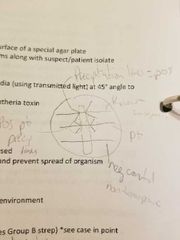
|
|
|
Treatment of diphtheria |
Administration of antitoxin Penicillin |
|
|
Listeria monocytogenes |
Gram positive coccobacilli Ubiquitous Morphology resembles group b Tumbling motility Likes cold temp |
|
|
How you get listeria |
Dairy or cold cuts |
|
|
How is listeria different from group B |
List- cat pos Grows in NaCl 6.5% Gram stain Grp B- cat neg No growth in NaCl 6.5% Gram stain |
|
|
Arcanobacterium haemolyticum |
Gram pos diptheroid like bacilli Small colony narrow zone hemolysis Pitting of agar under colony |
|
|
Test results for arcanobacterium haemolyticum |
Cat neg Reverse camp pos using s. aureus Camp pos using group B |
|
|
Reverse camp pos |
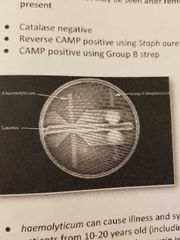
|
|
|
Haemolyticum illness |
Symptoms similar to group A strep In age of 10-20 years old Penicillin resistant |
|
|
Positive camp test |
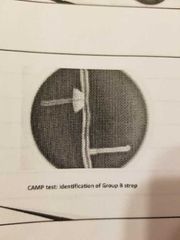
|

